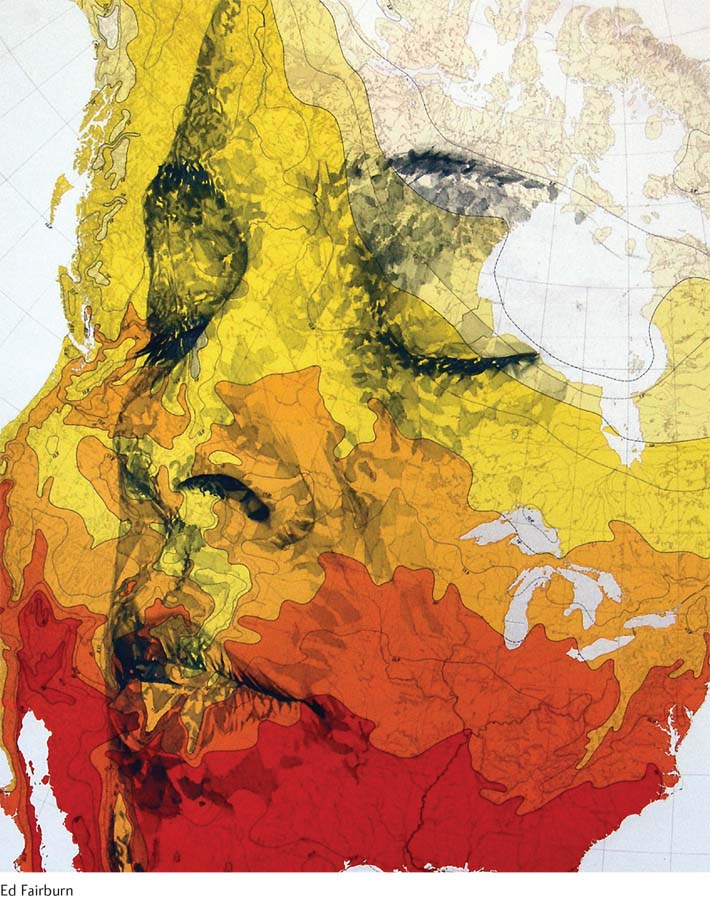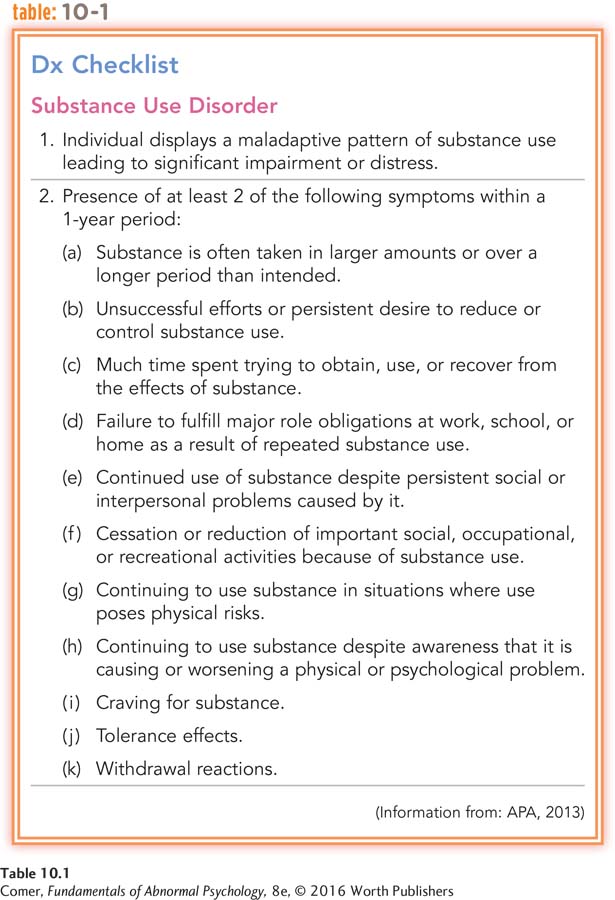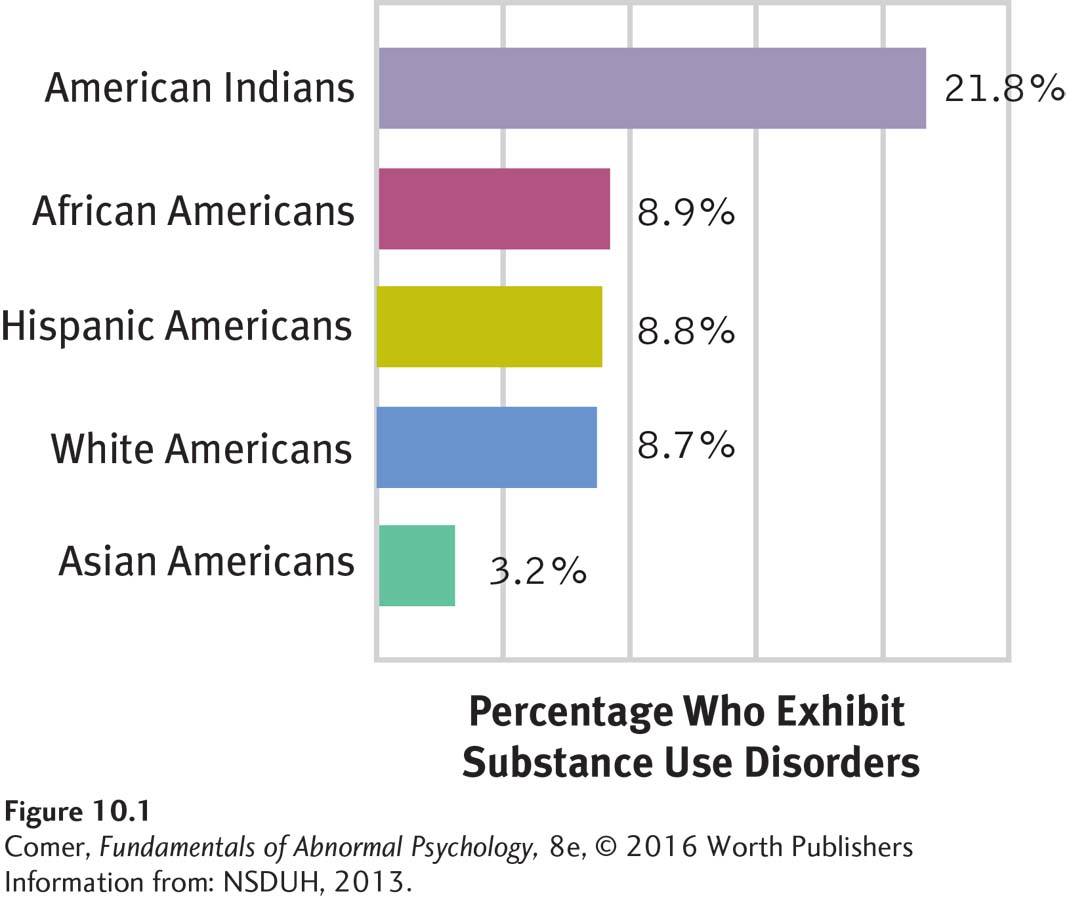Chapter 10 Introduction
CHAPTER 10
TOPIC OVERVIEW
Alcohol
Sedative-
Opioids
Cocaine
Amphetamines
Stimulant Use Disorder
Hallucinogens
Cannabis
Combinations of Substances
Sociocultural Views
Psychodynamic Views
Cognitive-
Biological Views
Psychodynamic Therapies
Behavioral Therapies
Cognitive-
Biological Treatments
Sociocultural Therapies
Gambling Disorder
Internet Gaming Disorder: Awaiting Official Status
Substance Use and Addictive Disorders

“I am Duncan. I am an alcoholic.” The audience settled deeper into their chairs at these familiar words. Another chronicle of death and rebirth would shortly begin [at] Alcoholics Anonymous….
“I must have been just past my 15th birthday when I had that first drink that everybody talks about. And like so many of them ….t was like a miracle. With a little beer in my gut, the world was transformed. I wasn’t a weakling anymore, I could lick almost anybody on the block. And girls? Well, you can imagine how a couple of beers made me feel like I could have any girl I wanted….
“Though it’s obvious to me now that my drinking even then, in high school, and after I got to college, was a problem, I didn’t think so at the time. After all, everybody was drinking and getting drunk and acting stupid, and I didn’t really think I was different…. I guess the fact that I hadn’t really had any blackouts and that I could go for days without having to drink reassured me that things hadn’t gotten out of control. And that’s the way it went, until I found myself drinking even more—
“My roommate, a friend from high school, started bugging me about my drinking. It wasn’t even that I’d have to sleep it off the whole next day and miss class, it was that he had begun to hear other friends talking about me, about the fool I’d made of myself at parties. He saw how shaky I was the morning after, and he saw how different I was when I’d been drinking a lot—
“Shortly after getting my law degree, I married my first wife, and ….or the first time since I started, my drinking was no problem at all. I would go for weeks at a time without touching a drop….
“My marriage started to go bad after our second son, our third child, was born. I was very much career-
“And as that went on, the drinking began to affect both my marriage and my career. With enough booze in me and under the pressures of guilt over my failure to carry out my responsibilities to my wife and children, I sometimes got kind of rough physically with them. I would break furniture, throw things around, then rush out and drive off in the car. I had a couple of wrecks, lost my license for two years because of one of them. Worst of all was when I tried to stop. By then I was totally hooked, so every time I tried to stop drinking, I’d experience withdrawal in all its horrors ….ith the vomiting and the ‘shakes’ and being unable to sit still or to lie down. And that would go on for days at a time….
“Then, about four years ago, with my life in ruins, my wife given up on me and the kids with her, out of a job, and way down on my luck, [Alcoholics Anonymous] and I found each other…. I’ve been dry now for a little over two years, and with luck and support, I may stay sober….”
(Spitzer et al., 1983, pp. 87–
Human beings enjoy a remarkable variety of foods and drinks. Every substance on earth probably has been tried by someone, somewhere, at some time. We also have discovered substances that have interesting effects—
Not only are numerous substances available in our society, but new ones are also introduced almost every day. Some are harvested from nature, others derived from natural substances, and still others produced in the laboratory. Some, such as antianxiety drugs, require a physician’s prescription for legal use. Others, such as alcohol and nicotine, are legally available to adults. Still others, such as heroin, are illegal under all circumstances. In 1962, only 4 million people in the United States had ever used marijuana, cocaine, heroin, or another illegal substance; today the number has climbed to more than 100 million (SAMHSA, 2014). In fact, 24 million people have used illegal substances within the past month. Almost 24 percent of all high school seniors have used an illegal drug within the past month (Johnston et al., 2014).
A drug is defined as any substance other than food that affects our bodies or minds. It need not be a medicine or be illegal. The term “substance” is now frequently used in place of “drug,” in part because many people fail to see that such substances as alcohol, tobacco, and caffeine are drugs, too. When a person ingests a substance—
substance intoxication A cluster of temporary undesirable behavioral or psychological changes that develop during or shortly after the ingestion of a substance.
Substances may cause temporary changes in behavior, emotion, or thought; this cluster of changes is called substance intoxication in DSM-
substance use disorder A pattern of long-
tolerance The brain and body’s need for ever larger doses of a drug to produce earlier effects.
withdrawal Unpleasant, sometimes dangerous reactions that may occur when people who use a drug regularly stop taking or reduce their dosage of the drug.

Some substances can also lead to long-

In any given year, 8.9 percent of all teens and adults in the United States, over 23 million people, have a substance use disorder (SAMHSA, 2014; NSDUH, 2013). American Indians have the highest rate of substance use disorders in the United States (21.8 percent), while Asian Americans have the lowest (3.2 percent). White Americans, Hispanic Americans, and African Americans have rates close to 9 percent (see Figure 10.1). Only 11 percent (around 2.5 million people) of all those with substance use disorders receive treatment from a mental health professional (Belendiuk & Riggs, 2014; NSDUH, 2013).
The substances people misuse fall into several categories: depressants, stimulants, hallucinogens, and cannabis. In this chapter you will read about some of the most problematic substances and the abnormal patterns they may produce. In addition, at the end of the chapter, you’ll read about gambling disorder, a problem that DSM-